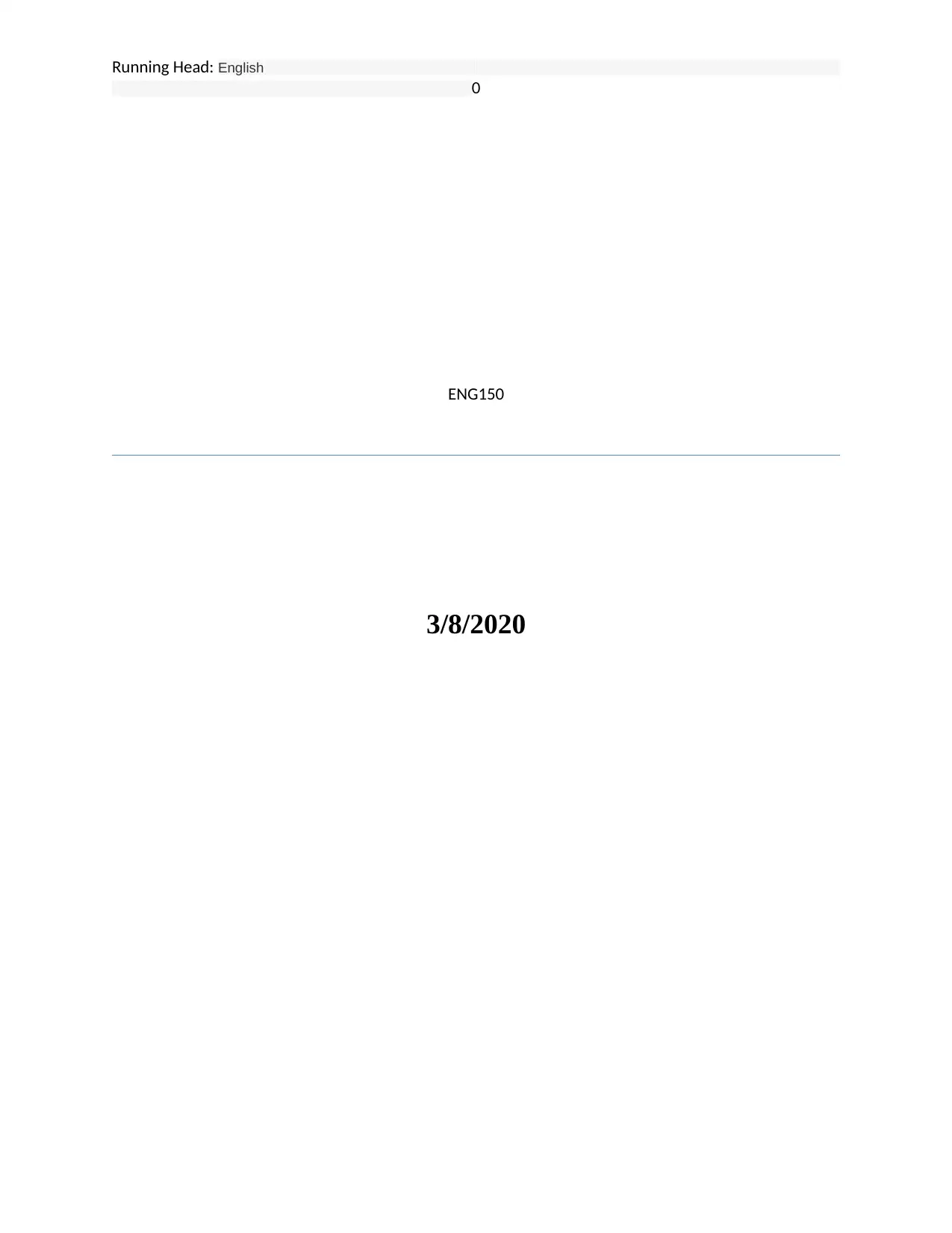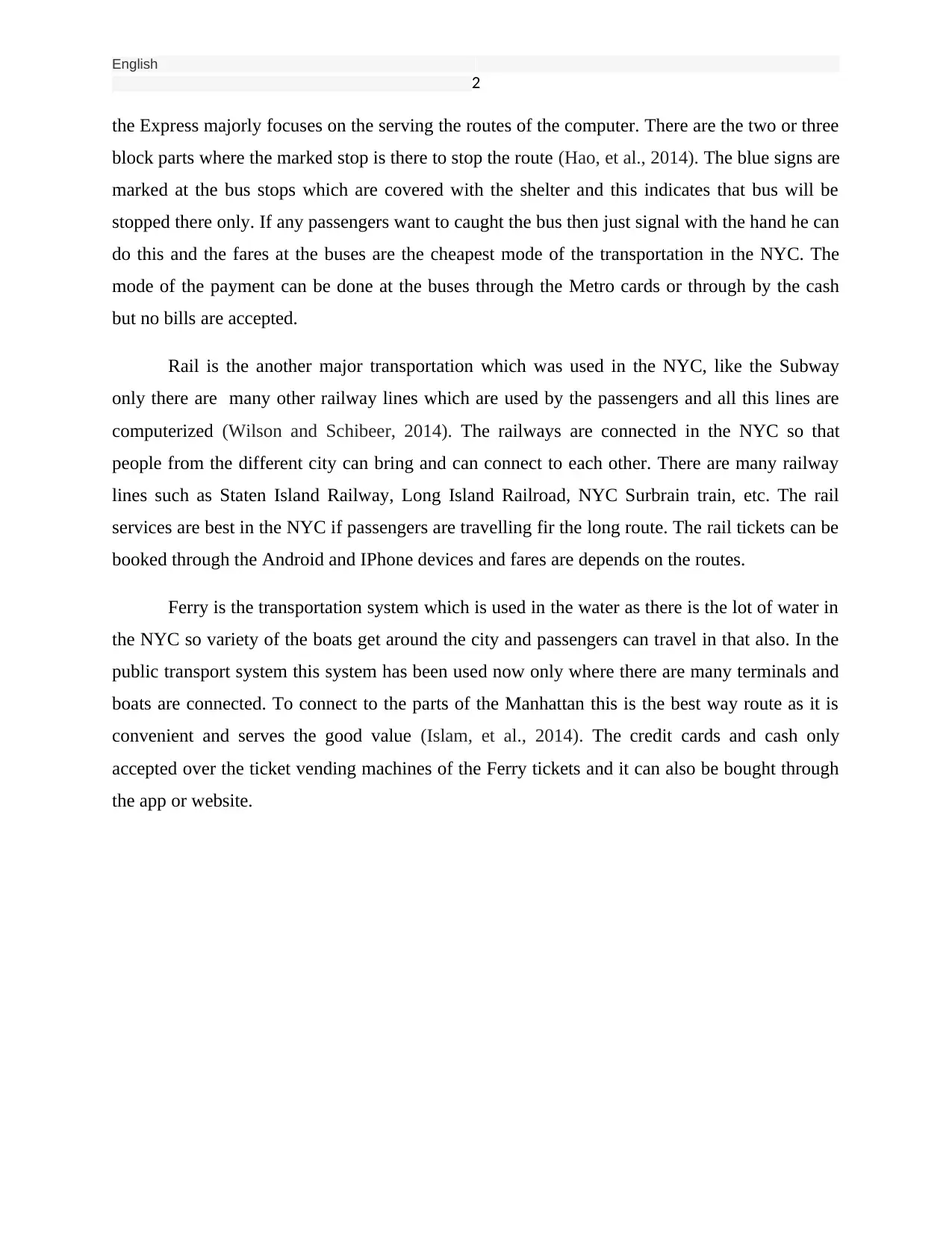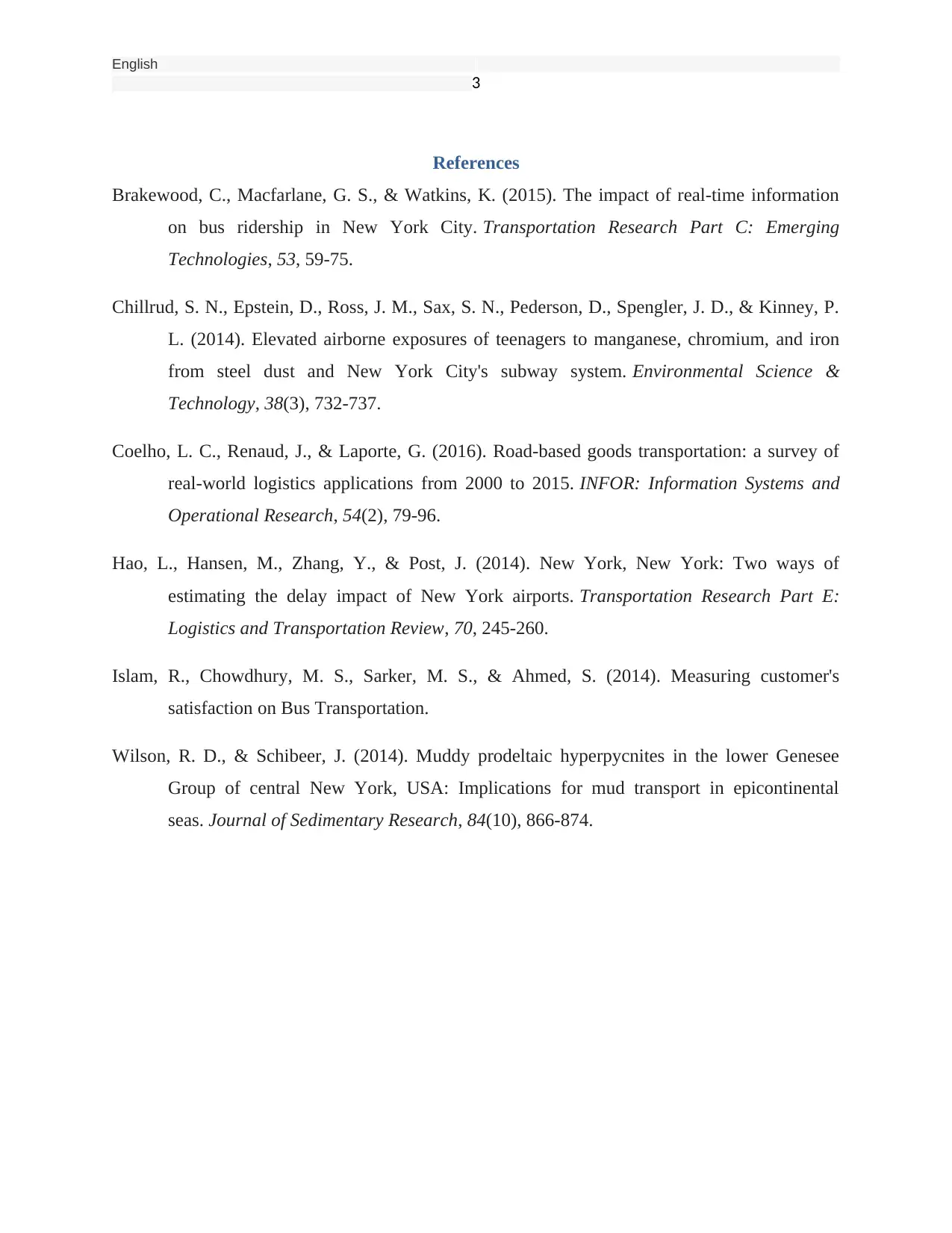ENG150 Report (3/8/2020): Analysis of NYC Transportation Systems
VerifiedAdded on 2022/08/19
|4
|1161
|9
Report
AI Summary
This report provides an overview of the major transportation systems in New York City. It examines five key modes: the subway, buses, taxis, rail, and ferries. The subway, known for its extensive network and 24/7 operation, is highlighted as a primary means of navigating the city. Taxis, including the iconic yellow cabs and ride-sharing services like Uber and Lyft, are also discussed as convenient options. The report also covers the bus system, detailing its routes and classification into express and local services. Additionally, it explores the rail system, connecting NYC to surrounding areas, and the ferry system, which utilizes the city's waterways. The report references several studies that support the facts and statistics about the transportation methods in NYC. The report concludes that these modes of transport are essential for the city's infrastructure and the daily lives of its residents and visitors.

Running Head: English
0
ENG150
3/8/2020
0
ENG150
3/8/2020
Paraphrase This Document
Need a fresh take? Get an instant paraphrase of this document with our AI Paraphraser

English
1
Five forms of transportation in NYC
There are any ways of the transportation in the New York City such as rail and bus
system, single subway, bus rides, etc. In the Unites states, NYC is the most population’s city
where the infrastructural system of transportation is complex (Chillrud, et al., 2014). NYC has
the largest Subway system in the world and also they are the first of the vehicular tunnel
mechanically ventilated in the world. The major five form of the transportation are subway and
bus, taxi, car, tram and bike, ferry, helicopter or cruise.
Subway is the most popular way of transportation in the NYC to get around anywhere.
To avoid the traffic of the city this transportation is the best way. There are 472 Subway stations
in the world which is the largest in the NYC and this operates twenty four hours a day. The sign
indicates the routes of the station and majority of the stations there is the map of network which
helps in finding the route (Brakewood, et al., 2015). The vending machines are there at this
station which helps in paying the cash through the tickets and through the Metro Cards. This
transportation system in the NYC is not only healthy but also technological and economical
benefited.
Taxi is also the popular way to roam her and there in the NYC. The local residents and
visitors also use the iconic yellow taxi which is easy to recognize and have the yellow light on
the roof. In the entire city no other vehicle can pick the passengers instead of the yellow taxis in
response to the street hail. Yellow lights indicate the illuminating light which is available for the
hire. By waving the driver also the taxi can be hailed by the passengers from the street corner
(Coelho, et al., 2016). All the taxis charge the fare starting from the $3 and they are charged as
per the metered and distance charged. If any tolls are paid then it is also added in the fare of the
taxi and can be paid through the credit and debit card. For the shorter rides they are the most
convenient transportation as they are not expensive. Uber and Lyft are the ride sharing services
which are used in the NYC and they are cheaper than the yellow cabs.
There are almost 6000 buses in the NYC which was operated by the MTA and covers
more than 322 routes. To meet the needs the bus route is the best way as they are generally
classified into the two express and local. From the Manhattan to the boroughs outer the routes of
1
Five forms of transportation in NYC
There are any ways of the transportation in the New York City such as rail and bus
system, single subway, bus rides, etc. In the Unites states, NYC is the most population’s city
where the infrastructural system of transportation is complex (Chillrud, et al., 2014). NYC has
the largest Subway system in the world and also they are the first of the vehicular tunnel
mechanically ventilated in the world. The major five form of the transportation are subway and
bus, taxi, car, tram and bike, ferry, helicopter or cruise.
Subway is the most popular way of transportation in the NYC to get around anywhere.
To avoid the traffic of the city this transportation is the best way. There are 472 Subway stations
in the world which is the largest in the NYC and this operates twenty four hours a day. The sign
indicates the routes of the station and majority of the stations there is the map of network which
helps in finding the route (Brakewood, et al., 2015). The vending machines are there at this
station which helps in paying the cash through the tickets and through the Metro Cards. This
transportation system in the NYC is not only healthy but also technological and economical
benefited.
Taxi is also the popular way to roam her and there in the NYC. The local residents and
visitors also use the iconic yellow taxi which is easy to recognize and have the yellow light on
the roof. In the entire city no other vehicle can pick the passengers instead of the yellow taxis in
response to the street hail. Yellow lights indicate the illuminating light which is available for the
hire. By waving the driver also the taxi can be hailed by the passengers from the street corner
(Coelho, et al., 2016). All the taxis charge the fare starting from the $3 and they are charged as
per the metered and distance charged. If any tolls are paid then it is also added in the fare of the
taxi and can be paid through the credit and debit card. For the shorter rides they are the most
convenient transportation as they are not expensive. Uber and Lyft are the ride sharing services
which are used in the NYC and they are cheaper than the yellow cabs.
There are almost 6000 buses in the NYC which was operated by the MTA and covers
more than 322 routes. To meet the needs the bus route is the best way as they are generally
classified into the two express and local. From the Manhattan to the boroughs outer the routes of

English
2
the Express majorly focuses on the serving the routes of the computer. There are the two or three
block parts where the marked stop is there to stop the route (Hao, et al., 2014). The blue signs are
marked at the bus stops which are covered with the shelter and this indicates that bus will be
stopped there only. If any passengers want to caught the bus then just signal with the hand he can
do this and the fares at the buses are the cheapest mode of the transportation in the NYC. The
mode of the payment can be done at the buses through the Metro cards or through by the cash
but no bills are accepted.
Rail is the another major transportation which was used in the NYC, like the Subway
only there are many other railway lines which are used by the passengers and all this lines are
computerized (Wilson and Schibeer, 2014). The railways are connected in the NYC so that
people from the different city can bring and can connect to each other. There are many railway
lines such as Staten Island Railway, Long Island Railroad, NYC Surbrain train, etc. The rail
services are best in the NYC if passengers are travelling fir the long route. The rail tickets can be
booked through the Android and IPhone devices and fares are depends on the routes.
Ferry is the transportation system which is used in the water as there is the lot of water in
the NYC so variety of the boats get around the city and passengers can travel in that also. In the
public transport system this system has been used now only where there are many terminals and
boats are connected. To connect to the parts of the Manhattan this is the best way route as it is
convenient and serves the good value (Islam, et al., 2014). The credit cards and cash only
accepted over the ticket vending machines of the Ferry tickets and it can also be bought through
the app or website.
2
the Express majorly focuses on the serving the routes of the computer. There are the two or three
block parts where the marked stop is there to stop the route (Hao, et al., 2014). The blue signs are
marked at the bus stops which are covered with the shelter and this indicates that bus will be
stopped there only. If any passengers want to caught the bus then just signal with the hand he can
do this and the fares at the buses are the cheapest mode of the transportation in the NYC. The
mode of the payment can be done at the buses through the Metro cards or through by the cash
but no bills are accepted.
Rail is the another major transportation which was used in the NYC, like the Subway
only there are many other railway lines which are used by the passengers and all this lines are
computerized (Wilson and Schibeer, 2014). The railways are connected in the NYC so that
people from the different city can bring and can connect to each other. There are many railway
lines such as Staten Island Railway, Long Island Railroad, NYC Surbrain train, etc. The rail
services are best in the NYC if passengers are travelling fir the long route. The rail tickets can be
booked through the Android and IPhone devices and fares are depends on the routes.
Ferry is the transportation system which is used in the water as there is the lot of water in
the NYC so variety of the boats get around the city and passengers can travel in that also. In the
public transport system this system has been used now only where there are many terminals and
boats are connected. To connect to the parts of the Manhattan this is the best way route as it is
convenient and serves the good value (Islam, et al., 2014). The credit cards and cash only
accepted over the ticket vending machines of the Ferry tickets and it can also be bought through
the app or website.
⊘ This is a preview!⊘
Do you want full access?
Subscribe today to unlock all pages.

Trusted by 1+ million students worldwide

English
3
References
Brakewood, C., Macfarlane, G. S., & Watkins, K. (2015). The impact of real-time information
on bus ridership in New York City. Transportation Research Part C: Emerging
Technologies, 53, 59-75.
Chillrud, S. N., Epstein, D., Ross, J. M., Sax, S. N., Pederson, D., Spengler, J. D., & Kinney, P.
L. (2014). Elevated airborne exposures of teenagers to manganese, chromium, and iron
from steel dust and New York City's subway system. Environmental Science &
Technology, 38(3), 732-737.
Coelho, L. C., Renaud, J., & Laporte, G. (2016). Road-based goods transportation: a survey of
real-world logistics applications from 2000 to 2015. INFOR: Information Systems and
Operational Research, 54(2), 79-96.
Hao, L., Hansen, M., Zhang, Y., & Post, J. (2014). New York, New York: Two ways of
estimating the delay impact of New York airports. Transportation Research Part E:
Logistics and Transportation Review, 70, 245-260.
Islam, R., Chowdhury, M. S., Sarker, M. S., & Ahmed, S. (2014). Measuring customer's
satisfaction on Bus Transportation.
Wilson, R. D., & Schibeer, J. (2014). Muddy prodeltaic hyperpycnites in the lower Genesee
Group of central New York, USA: Implications for mud transport in epicontinental
seas. Journal of Sedimentary Research, 84(10), 866-874.
3
References
Brakewood, C., Macfarlane, G. S., & Watkins, K. (2015). The impact of real-time information
on bus ridership in New York City. Transportation Research Part C: Emerging
Technologies, 53, 59-75.
Chillrud, S. N., Epstein, D., Ross, J. M., Sax, S. N., Pederson, D., Spengler, J. D., & Kinney, P.
L. (2014). Elevated airborne exposures of teenagers to manganese, chromium, and iron
from steel dust and New York City's subway system. Environmental Science &
Technology, 38(3), 732-737.
Coelho, L. C., Renaud, J., & Laporte, G. (2016). Road-based goods transportation: a survey of
real-world logistics applications from 2000 to 2015. INFOR: Information Systems and
Operational Research, 54(2), 79-96.
Hao, L., Hansen, M., Zhang, Y., & Post, J. (2014). New York, New York: Two ways of
estimating the delay impact of New York airports. Transportation Research Part E:
Logistics and Transportation Review, 70, 245-260.
Islam, R., Chowdhury, M. S., Sarker, M. S., & Ahmed, S. (2014). Measuring customer's
satisfaction on Bus Transportation.
Wilson, R. D., & Schibeer, J. (2014). Muddy prodeltaic hyperpycnites in the lower Genesee
Group of central New York, USA: Implications for mud transport in epicontinental
seas. Journal of Sedimentary Research, 84(10), 866-874.
1 out of 4
Related Documents
Your All-in-One AI-Powered Toolkit for Academic Success.
+13062052269
info@desklib.com
Available 24*7 on WhatsApp / Email
![[object Object]](/_next/static/media/star-bottom.7253800d.svg)
Unlock your academic potential
Copyright © 2020–2025 A2Z Services. All Rights Reserved. Developed and managed by ZUCOL.




